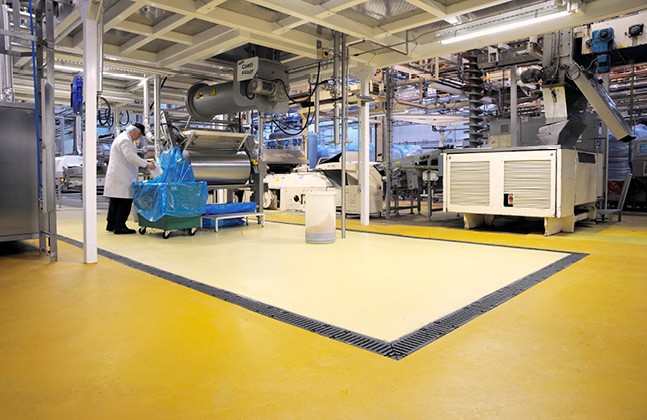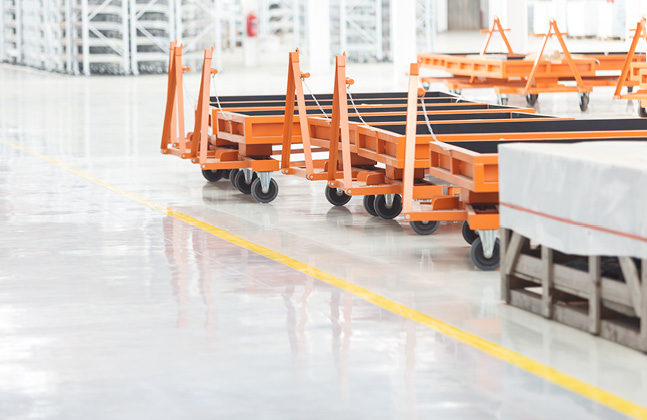When operating a facility where heavy footfall and wheeled traffic are just part of the daily routine, maintaining clean and safe flooring can be an absolute nightmare.
Without the correct maintenance, bacteria, dirt and other pesky contaminants can find their way inside buildings and onto factory and warehouse floors, causing excessive wear and tear as well as increasing the risk of costly slips and trips in the workplace.
Top quality flooring is expensive and the only way to secure your investment is by being pro-active and following best practice cleaning methods. Here are our five tips to help you prepare and protect your company’s floor while keeping costs down.
1- Weekly maintenance
Get your broom out at least once a week and sweep the floor of debris to prevent dirt and dust building up on the surface; this will help guard against unforeseen issues over time.
Spillages are inevitable, so when they do happen deal with them promptly! For a small spill paper towels and cloths will do the trick. For anything bigger use a hard foam mop with plenty of hot water and steam, accompanied by an industrial cleaning product such as Trisodium Phosphate (TSP) this will make light work of it.
2- Always Use the Correct Cleaning Products
For cementitious urethane floors, products such as: citrus cleaners, peroxyaetic acid, vinegar cleaners, acid cleaners and all-purpose cleaners are ideal. Keep in mind that you cannot go wrong with hot water and steam cleaning either!
When it comes to epoxy flooring systems 4-5oz. of ammonia and water works well, as does dishwashing liquid and all-purpose cleaners. But abrasive products, acid based solutions and alkali based concentrated cleaning products must be avoided with this type of flooring.
3- Beware of Damaging Chemicals
Using a stiff bristle brush and some hot water can help to prevent cold weather road pre-treatments from leaving a hazy film residue on your surface, and it is an easy way to prevent damage and deterioration.
It is true that harsh chemicals can be diluted at the time of a spill but if they are not cleaned thoroughly the water will evaporate, leaving the substance behind in concentrated form, further enhancing the potential for damage.
It is also a good idea to avoid over the counter abrasive cleaning chemicals when dealing with epoxy flooring. Otherwise, this can create a buffed look on the surface and eventually lead to unsightly scratches and scoring.
4- Avoid Unnecessary Expenses
Scoring damage and scratches are common place in industrial environments but if they’re not treated immediately then chemicals and grime will fill the gaps and cause severe surface stains, costing more money to put right in the long-term.
Sand, dirt and small particles can also be problematic by causing an abrasive layer, which could prematurely damage the floors, costing more money in the future. This is why it is vital to avoid surface build up!
Excess dirt and wet flooring increase the risks of slips, trips and falls creating potentially hazardous situations for facility workers, visitors and staff. Accidents can cause lawsuits, which hit the company bank balance hard, so it pays to be vigilant and keep your working environment safe at all times.
5- If Renovations are Needed, Invest Wisely
The cost of maintaining floors in industrial, institutional and commercial facilities can be substantial and budget cuts from shortsighted managerial figures can make it even more difficult.
Although trimming the maintenance budget might reduce costs in the short term, it can be a hugely detrimental decision in the long run. Managers should develop a plan that classifies the facility by area usage, as well as the environment and traffic conditions that the floors are exposed to before beginning with cost cutting exercises.
When relaying or choosing new flooring, life-cycle costing must be taken into account because the cheapest option is rarely the best bet in years to come. You only get what you pay for, and looking at how long a floor will last protects the organisation’s investment and will help managers to achieve goals related to cleanliness, appearance and safety.








